Grace from the *&% # – hole

From Haiti, our artists respond to President Trump’s poisonous words with messages of kindness and wisdom.

From Haiti, our artists respond to President Trump’s poisonous words with messages of kindness and wisdom.
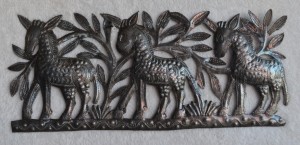
“Animals Garden,” by Salomon Jean Belony. An alternate title could be “Polo Ponies off to Play.” Could be, right?
Every once in a while, Haiti makes the news for something that is completely unexpected. Today it came to me in the form of a recent article by Carine Fabius in The Huffington Post entitled, “Playing Polo in Haiti.” (http://www.huffingtonpost.com/carine-fabius/playing-polo-in-haiti_b_6419634.html ) And not just playing; the Haitians are winning hardware, having brought home titles from the likes of the San Francisco International Polo Classic in the U.S., the China Open Polo Tournament in Shanghai, China, and the International Master’s Cup in Pilar, Argentina.
Apparently, global participation in the sport is on a meteoric rise, according to the polo-dedicated periodical, “Sideline,” so why not in Haiti? Haitian Polo Team Captain AND President Michel Martely’s recent appointee as UNESCO Goodwill Ambassador, Claude Alix Bertrand is spear-heading the effort revitalize the sport in Haiti. It had reportedly enjoyed some popularity in the 1920s and 1930s, but lost ground to football (soccer) in the ensuing decades. Bertrand is hoping to change all of that by leading the Haitian national polo team and winning big. So far, so good on that score.
He also hopes to make polo more accessible to Haiti’s (generally underprivileged) youth. He proposes to do that by helping to develop a world-class polo resort. The five-star 8,000 acre vision for Cote de Fer on Haiti’s southeast coast includes a polo grounds and school, golf courses, a marina for sailing, and a track for Formula One racing.The resort project is favored by some impressive financial backers includ Audi Sportscar Experience, Duty Free America and Digicel; it also has a healthy working relationship with the Ministry of Tourism in Haiti. (This was the same office that brought ice skating to Port-au-Prince in 2014. See blog https://www.itscactus.com/blog/2013/08/30/port-au-prince-the-chill-factor/ ) “Haitian youth will have access to polo like never before, says Bertrand, “because they will not be required to have club memberships to learn and play. All they’ll have to do is pay for their lessons, which will include instruction, gear,
horses, and time on the practice grounds.”
In a Bay Area news telecast in October, Bertrand told the interviewer that a single polo lesson in San Francisco costs somewhere in the neighborhood of $120. Now, I am sure there is a certain price adjustment to be made from the Bay Area to southeastern Haiti, but in a country where the minimum daily wage is right around $5 and forty percent or the workforce is not employed at all, that seems like a bit of a financial stretch.
Nevertheless, hope springs eternal. Bertrand should certainly be applauded for bringing pride and success home to Haiti. His sport is a great one, combining outdoor exercise, spirit of teamwork, competition and camaraderie, and working with animals. All positives, to be sure. Why not polo in Haiti? Maybe it will work, who knows? It’s just a little unexpected.
Contributed by Linda for It’s Cactus
Honey has always been in great demand in Haiti and there was a time when the island country’s needs were met by local beekeeping. However, political upheaval, environmental degradation, and a bee blight combined for a triple whammy that nearly killed Haitian production. Those beekeepers that continued to struggle on did not have access to information or tools which would allow them to maximize production and in fact, it is something of a miracle that they were able to harvest honey at all under the circumstances. Most beekeepers were reduced to not using hives, but rather tending to the bees wherever they happened to build their nests. Others were managing their bees in traditional hollow log hives, harvesting the honey by smoking the bees out and then removing the honey after the bees left. Though that method is inexpensive for the beekeeper, the honey retains a smoky taste and the farmer is unable to check brood health without damaging the comb. A sorry state of affairs no matter how you slice it.
Enter Farmer to Farmer, a program administered by Partners of the Americas and Funded by USAID. Farmer to Farmer set out to reestablish the once thriving beekeeping industry in the country by sending successful beekeepers and agriculturists from the United States to Haiti. Their goals were simple: train young Haitians to work in the industry; help transition old hives to more modern ones; and educate beekeepers about disease, production and processing. As a result of their efforts, many Haitians are producing enough honey for their own communities with plenty of extra to sell to others. Just one year after the Farmer to Farmer program began its work, more than 1,000 beekeepers returned to raising bees and more than 300 hives were restructured. Honey production has increased from three to seven gallons per hive, generating significant income for Haitian beekeepers. In addition, beekeepers are now communicating with each another and forming beekeeping associations, recognizing the need to organize in order to increase profits and reduce costs.
The amber liquid along with other hive products like propolis hold countless health benefits, which make producing it an ideal industry for impoverished nations. It has antibacterial properties that make it an effective topical agent for wounds. It is used as a skin care product, a sweetener for foods and beverages, and as a treatment to take the sting out of sore throats. The honey business has also provided micro-enterprise opportunities for women in Haiti who use the beeswax to make candles and crafts for sale.
Meghan Oliver, a program officer of the Farmer to Farmer Beekeeping Project believes that revitalizing local enterprise is a key ingredient in eliminating the cycle of poverty in countries such as Haiti. In the case of reviving honey production, she says, “Increasing cash in the hands of poor farmers is going to empower them immeasurably. The money they earn can be spent on their most important needs, whether it’s a generator for electricity, for repairs to their home or school fees for their kids. The best thing is that THEY earn and THEY decide.”
Contributed by Linda for Beyond Borders/It’s Cactus
Written for Patrick, because he asked…
Back in October, when I was in Haiti, I was looking at an intricate sculptural depiction of the voodoo ceremony at Bwa Kayman that set off the Haitian Revolution. There was a lot of symbolism worked into the scene, every detail fraught with meaning, so I was taking my time, looking it over very carefully and asking a lot of questions. When I spied an owl sitting in a tree, I asked our translator about its significance. Roosevelt’s face visibly darkened as he replied, “Oh owls are bad – very bad. Evil.” Then, he shook his head, “An owl has powerful black magic. You don’t ever want to mess with that.” I made a mental note to look into it further, and so here we are:
There are two different loas (Voodoo spirits) associated with owls. The first and by far the most ominous is Marinette, who takes the form of a screech owl and is clearly the one to whom Roosevelt referred. She is believed to have been the Mambo priestess that sacrificed the black pig at Bwa Kayman. Cruel, vicious, raging, and vengeful, she is greatly feared. She metes out justice with a powerful, violent hand and possesses the ability to free people from bondage or send them into slavery, at her pleasure. Knowing that after the Bwa Kayman ceremony, slaves slipped their chains to freedom while French slaveholders were slaughtered by the hundreds, it is clear that Marinette is not to be trifled with.
The second loa associated with an owl is named Brise, guardian of the hills and woodlands. Though he appears to be fierce, with large, dark, exaggerated features, he is actually quite gentle and loves children. Brise seems to be the basis of a widely recognized children’s folktale, which is elegantly retold in English in Diane Wolkenstein’s book “The Magic Orange Tree.” (For more on her book, click here http://dianewolkstein.com/projects/haiti-and-the-magic-orange-tree/ )
In the story, a shy owl encounters a lovely young girl in the woods at night. They talk and agree to meet again and again and during the course of their encounters, fall in love and agree to marry. The only problem is that the young girl has never seen the face of the owl and he is afraid to show it because he is ugly. He ends up flying away, alone, ashamed, and unwilling to believe that he could be worthy of a lifetime of love. The girl eventually finds a new love, but her happiness is forever shadowed by the melancholy of her previous loss. Far from being fierce and powerful, the owl in this story is self-effacing and unsure. Pretty significant contrast, I’d say.
Then on the other hand, across the Carribean and a good bit of land mass are “my” owls; wise and all-knowing. What likely formed the basis for my line of thinking is a simple British poem written in the 19th century that I learned in second grade. Bet you did too:![il570xN264988494[1]](https://blog.itscactus.com/wp-content/uploads/2013/02/il570xN2649884941.jpg)
“The Wise Old Owl lived in the oak
The more he saw, the less he spoke.
The less he spoke, the more he heard.
Why can’t we be like that wise old bird?”
How different my impression of owls is from those depicted in Haitian lore! It has nothing to do with the bird itself and everything to do with the stories I was told as a kid. Cultural heritage. Pretty interesting, isn’t it?
Contributed by Linda for Beyond Borders/It’s Cactus
![9989448953c75b22[1]](https://blog.itscactus.com/wp-content/uploads/2012/11/9989448953c75b221.jpg)
Birds flying through the flowers, by Louiceus Antelus
Real-live flesh and feather birds are having quite the struggle for survival, given the heavy toll that deforestation has taken on their habitats. Yet this is the land where John James Audubon, the great American ornithologist, naturalist, and painter was born.
Yes, you read that right. John James Audubon, born in Les Cayes, in what was then the French colony of Saint-Domingue on April 26, 1785. And though not all of the story is clear, it is intriguing, to say the least. Of his own origins, Audubon wrote, “The precise period of my birth is yet an enigma to me.” There is considerable weight to the theory that it was not so much an enigma to him as it was a hesitation to disclose, what with legitimacy and claims to inheritance hanging in the balance. The family as a whole was evasive on the subject. Long after he was gone, his own granddaughter wrote that Audubon was, in her belief, possessed of royal Bourbon characteristics and, “in fact, the Dauphine of France, child of the martyred Louis XVI and Marie Antoinette who mysteriously disappeared during the French Revolution.” He was also said to have been born in Louisiana, son of a French Naval officer and creole mother, who took ill on a Mississippi River flatboat moored at Nine Mile Point and died in childbirth. The city of New Orleans was only too happy to claim him as their native son and erected a bronze statue of him to emphasize the point.
It was not until 1917, a full 66 years after Audubon’s death that legal documents were brought forth by Audubon biographer, Francis Hobart Herrick. These documents established that Audubon was born the son of the swash-buckling Captain Jean Audubon – a sometime gentleman planter and sometime privateer in the service of the French navy – and his creole mistress, Jeanne Rabine in their home in Les Cayes, Saint-Domingue. At birth, he was given the name Jean Rabine. His mother died a few months later under unclear circumstances and Jean went to live with another of Captain Audubon’s island mistresses and his half-sister, Muget Bouffard. At the age of four, Captain Audubon became wary of the clouds of slave unrest gathering over Saint Domingue and fled with his two young children to his French homeland and legal wife of seven years. Madame Audubon greeted the three with love and grace at the family estate near Nantes, France and raised the children as her own henceforward. When Jean Rabine was eight years old, his parents sought to secure his legitimacy and rightful inheritance by adopting him and changing his name to Jean Jacques Forgere Audubon. Thereby, his status as a bastard child of Haitian origins were buried and remained so for the rest of his life.
From there, Jean Audubon’s story becomes well known, though
![200px-John_James_Audubon_1826[1]](https://blog.itscactus.com/wp-content/uploads/2012/11/200px-John_James_Audubon_182611.jpg)
Portrait of John James Audubon by John Syme
claims to have been a student of art under the tutelage of court portraitist, Jacques Louis David, where he refined his artistic eye. However, bemoaning the “boring nature” of his subject matter, that being still-lifes and backgrounds, he left David’s atelier after a few months. In 1789, with his father’s encouragement and blessings, Audubon sailed for the United States to avoid conscription in Napoleon’s army. After a few fits and starts, the handsome French dandy, Jean Jacques Audubon became John James Audubon, American woodsman, distinguished naturalist, and internationally acclaimed artist. His magnum opus, “Birds of America” to this day remains a landmark work of art and ornithology.
Okay. So maybe this is more information about Audubon and birds than you were looking for in one sitting. But it could win you a round in Trivial Pursuit. Enjoy your victory, with my compliments!
Contributed by Linda for Beyond Borders/It’s Cactus
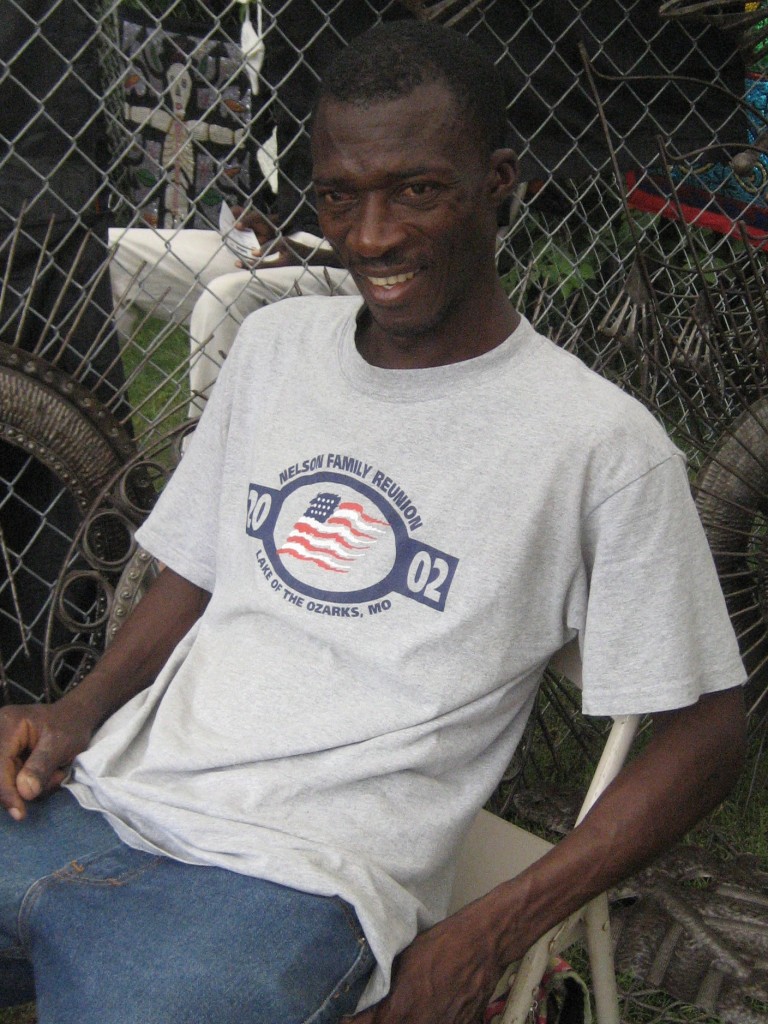 Well into our third day in Haiti, while I was supposed to be looking for new product for the winter wholesale and retail show season, I will admit, I got distracted. It’s not that the art wasn’t great or that I wasn’t “into it,” but by late in the afternoon, my attention had started to drift. Instead of looking at metal sculpture, I was looking at clothing. Reading tee-shirts, in fact, and it was becoming good sport. I saw a Green Bay Packers shirt with a #4 on it – an old one, clearly. Brett Favre hasn’t played for them in 4 years now. But it’s a goodie, and hey, that’s my team! Go Pack Go! And I saw a Carolina Panthers jersey. Ooooh, not so much. But it wasn’t ‘til I noticed a tee-shirt reading “Nelson Family Reunion 2002, Lake of the Ozarks, MO” that I wondered, “How did he end up with THAT?”
Well into our third day in Haiti, while I was supposed to be looking for new product for the winter wholesale and retail show season, I will admit, I got distracted. It’s not that the art wasn’t great or that I wasn’t “into it,” but by late in the afternoon, my attention had started to drift. Instead of looking at metal sculpture, I was looking at clothing. Reading tee-shirts, in fact, and it was becoming good sport. I saw a Green Bay Packers shirt with a #4 on it – an old one, clearly. Brett Favre hasn’t played for them in 4 years now. But it’s a goodie, and hey, that’s my team! Go Pack Go! And I saw a Carolina Panthers jersey. Ooooh, not so much. But it wasn’t ‘til I noticed a tee-shirt reading “Nelson Family Reunion 2002, Lake of the Ozarks, MO” that I wondered, “How did he end up with THAT?”
Of course the answer lies in the practice of US charitable organizations sending bales and bales of clothing – to the tune of 14.5 million tons annually – to the Third World. According to www.planetaid.org only 20% of all clothing donated in the United States is actually sold in the United States to be worn. Five percent ends up in a landfill, and the rest is sold to wholesalers; 45% is repurposed (as cloth wipes, carpet backing, insulation, etc.) and 30% goes to market in developing countries. World Vision, for example, accepts 100,000 sweatshirts, tee-shirts and hats every year from the NFL, which routinely anticipates BOTH teams as the eventual winner of the Super Bowl and prints accordingly. The items that end up proclaiming the losing team as Super Bowl Champions go straight to the African continent.
So is that a good thing? Well, after due consideration, and a fair amount of research, I can tell you plainly that I don’t really know. There is well documented evidence that suggests that the overwhelming volume of textile donations from the Developed World, meaning the US, Europe, Australia, and parts of Asia, to the Third World is exceedingly detrimental to domestic textile and garment industries in the receiving countries. Case in point: A 2008 study done by Garth Frazer of the University of Toronto revealed that wealthy countries shipping tons of used clothing caused a 40 percent decline in domestic African clothing production and a 50 percent decline in employment between 1981 and 2000. The availability of free clothes from America and Europe undercut local markets and closed businesses. According to The Nation, between 1992 and 2006, 543,000 textile workers in Nigeria alone lost their jobs.
Furthermore, there are costs associated with this type of charitable giving. Again using World Vision as an example, it has been reported by Aid Watch that that organization spends 58 cents per shirt on shipping, warehousing, and distribution. This is well within the range of what a secondhand shirt costs in a developing country. The recommended alternative in each of these reports is to send money instead of clothing to meet immediate need. Goods purchased locally supports local producers and bolsters local markets. Additionally, it eliminates most shipping and transportation costs, which enables the donated dollar to go farther, i.e. it will buy more shirts and clothe more people. Local purchases lead to increased employment and a strengthened economy, ideally to the point where the needy aren’t needy anymore.
I tried and tried to find out how this plays out in Haiti. Haiti does, in fact, have a garment industry. Coincidentally, Bill and Hilary Clinton were in Haiti at about the same time we were (No, we didn’t get together for cocktails, but we’ll try to coordinate on the next visit!) to celebrate the opening of a new industrial park at Caracol, which includes a clothing piecework center that will potentially employ 65,000 people. An actual mill is slated for later development at this same site. Currently, however, this industry is piecework only. Workers receive pre-dyed, pre-cut tee-shirt “pieces” which they sew together for direct shipment to foreign markets, where they are sold by Walmart, Target and The Gap, among others. So it seems to me that, as of now, the importation of used clothing is not adversely affecting local production because the local production is for overseas markets anyway.
There is, however, a huge trade in Haiti that has been built around imported second-hand clothing. In fact, there is a Kreyol word for it: “Pepe.” According to Joanne McNeil’s blog article on reason.com, “It’s all pepe, all the time.” Pepe is sold on virtually every street corner in Haiti, yet it isn’t a 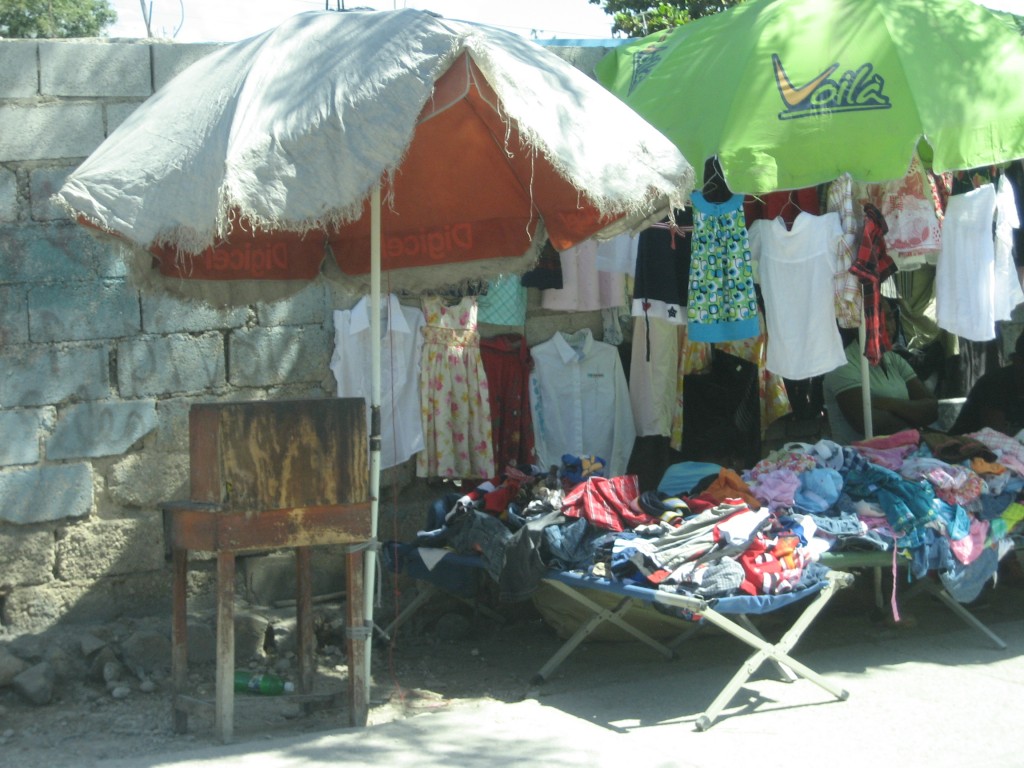 free-for-all. Vendors purchase goods by the bale for resale in ports such as Miragoane, where shipments are unloaded virtually every day. Often the dealers have an agreement with an American charity shop, which sorts the items before making the sale. Others rely on relatives and friends in the United States, who return to Haiti several times a year to make deliveries. Vendors typically specialize in certain kinds of goods—just soccer jerseys, just sneakers, just bikinis – but their total impact is such that 80% of all clothing bought and sold in Haiti is pepe. (Watch a trailer for a film on this subject here: http://secondhandfilm.com/project.html )
free-for-all. Vendors purchase goods by the bale for resale in ports such as Miragoane, where shipments are unloaded virtually every day. Often the dealers have an agreement with an American charity shop, which sorts the items before making the sale. Others rely on relatives and friends in the United States, who return to Haiti several times a year to make deliveries. Vendors typically specialize in certain kinds of goods—just soccer jerseys, just sneakers, just bikinis – but their total impact is such that 80% of all clothing bought and sold in Haiti is pepe. (Watch a trailer for a film on this subject here: http://secondhandfilm.com/project.html )
Well, that’s nothing, if not resourceful, in my book. It goes right along with the whole idea of recycling, reducing, and reusing. Admittedly, it’s not ideal. I’d like for them to have crisp, brand-new clothing, and tee-shirts that shout support for their own football (soccer) teams. But it is a legitimate trade, and it’s flourishing. It meets a need. And how bad is that?
A few weeks ago, there was an article in the Des Moines Register about gold having been discovered in the heart of the northern highlands of Haiti. It was optimistically reported that the vast mineral reserves, worth an estimated $20 billion, have the potential of being salvation for the poorest country in the Western Hemisphere. Further examination, however, leads one to wonder. It could indeed be a “golden” opportunity for the nation as a whole. Job creation, money for public works, government investment in education – all of that and more is possible. The other side of the golden coin is that the only ones who might really come out ahead are the foreign investors and a few influential Haitians seeking to line their own pockets by granting lucrative permits for exploration and mineral extraction.
![sm355[1]](https://blog.itscactus.com/wp-content/uploads/2012/06/sm35513.jpg)
So which is it?
According to Jane Regan, lead author of a recent report by Haiti Grassroots Watch, there is a perfect storm brewing. “Giant pit mines are being dug by Canadian and American companies in a country that is already environmentally devastated. Most of the money and gold dug up will go out of Haiti, straight north.” She might have something there. In the report, there were interviews of farmers in the Dominican Republic, at the other end of the mineral veins.
They complained of being displaced from their farms by these same North American companies, and left with no means of providing for themselves. Because mining is such a highly mechanized process, very few jobs were created for the local Dominican populace. Skilled labor, it turned out, was imported.
On the other hand, World Bank’s Sustainable Development Vice President Rachel Kyte takes a much different view. “When public and private sectors work in partnership, gold mining can have real and positive benefits for the communities around the mining sites and for the mining countries in general. It is possible to make concrete progress when and wherever there is the political will and a robust regulatory framework to ensure that the revenues are well-managed and invested in sustainable development.” Thus, it seems a beneficial outcome in Haiti is possible if the Haitian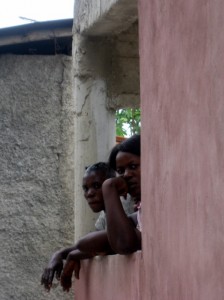 government steps up to protect its own.
government steps up to protect its own.
Apparently there are a few heavy hitters in government ready to rise to the occasion. As reported on hindu.com, Prime Minister Laurent Lamothe said, “The most important thing is to have the correct mining law. It ensures that the right portion comes to the state. It ensures that the people living in the region where the mines are, that their rights are protected. It ensures environmental protection.” Deiuseul Anglade concurs. In a Huffington Post article dated May 11th, the Bureau of Mines Director is quoted as saying, “If the mining companies are honest and if Haiti has a good government, then here is a way for this country to move forward. The gold in the mountains belong to the people of Haiti. And they need it”
Yes it does, and yes they do. Actions, however, speak louder than words. Enough said.
Travel is such a mind-broadening experience. From the monumental to the minute, there are things to be learned and observations to be made. So, sitting on the patio of the hotel on the outskirts of Port-au-Prince, sipping a hard-earned brew at the end of the day, I noticed this huge, chartreuse-colored, bumpy, round fruit growing in a tree above me. Thinking I’d seen it in an Asian food market somewhere along the line, I wondered A) What it was and B) What it was doing here.
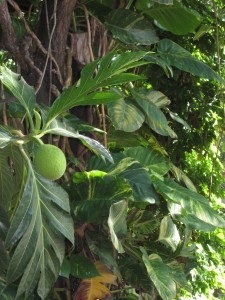 A little on-line investigation revealed that it was breadfruit. Originating in the South Pacific, the species was spread throughout Oceania by intrepid islanders settling the numerous islands of Melanesia, Micronesia, and Polynesia. Due to the efforts of Captain Bligh and French voyagers, a few seedless varieties from Polynesia were introduced to the Caribbean in the late 1700s. These gradually spread to other tropical regions. Breadfruit is now grown in close to 90 countries. Countries like Haiti, apparently.
A little on-line investigation revealed that it was breadfruit. Originating in the South Pacific, the species was spread throughout Oceania by intrepid islanders settling the numerous islands of Melanesia, Micronesia, and Polynesia. Due to the efforts of Captain Bligh and French voyagers, a few seedless varieties from Polynesia were introduced to the Caribbean in the late 1700s. These gradually spread to other tropical regions. Breadfruit is now grown in close to 90 countries. Countries like Haiti, apparently.
Breadfruit is a versatile crop and the fruit can be cooked and eaten at all stages of maturity. It is mainly grown as a subsistence crop in home gardens or small farms and is an excellent dietary staple, comparing favorably with other starchy staple crops commonly eaten in the tropics, such as taro, plantain, cassava, sweet potato and white rice. Carbohydrates are the main source of energy. Additionally, breadfruit is a good source of dietary fiber, potassium, calcium, and magnesium, with small amounts of thiamin, riboflavin, niacin and iron. The seeds are edible, resembling chestnuts in flavor and texture. They can be boiled, roasted, or ground into meal and are a good source of protein and minerals. (Incidentally, recipes can be found at: www.ntb.org/breadfruit)
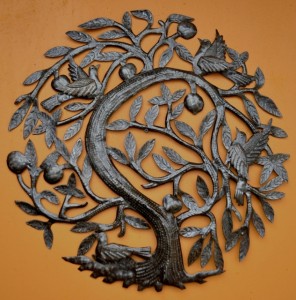 The trees begin bearing fruit in 3 to 5 years and are productive for many decades. They require little attention or care, and can be grown under a wide range of ecological conditions. Throughout its range, breadfruit is grown in home gardens and small farms interplanted with a mix of subsistence crops, cash crops, and other useful plants. The trees form a protective overstory providing shade, mulch, and a beneficial microclimate. Cultivating breadfruit trees protects watersheds; replacing slash-and-burn agriculture and field cropping with a permanent tree cover. What a wonderful crop to plant in Haiti, where deforestation is at a whopping 98% and watershed damage due to erosion is tremendous.
The trees begin bearing fruit in 3 to 5 years and are productive for many decades. They require little attention or care, and can be grown under a wide range of ecological conditions. Throughout its range, breadfruit is grown in home gardens and small farms interplanted with a mix of subsistence crops, cash crops, and other useful plants. The trees form a protective overstory providing shade, mulch, and a beneficial microclimate. Cultivating breadfruit trees protects watersheds; replacing slash-and-burn agriculture and field cropping with a permanent tree cover. What a wonderful crop to plant in Haiti, where deforestation is at a whopping 98% and watershed damage due to erosion is tremendous.
Thinking this over, I looked at some of the tree of life metal sculptures on our website. (www.itscactus.com) Bingo – the breadfruit was there. Tree of life. How appropriate.